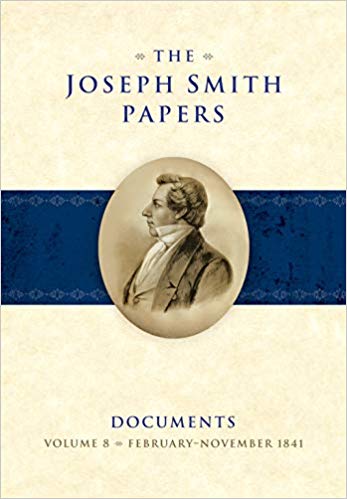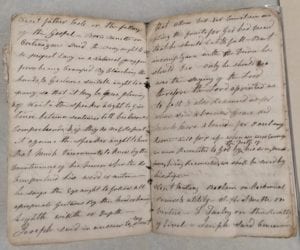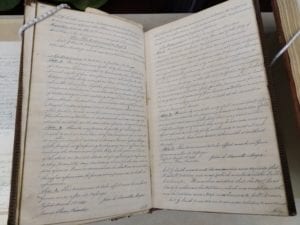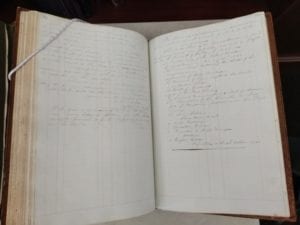
This volume consists of 544 pages (including the usual introductions, reference material, and index) but covers only ten months of 1841. My first impression from reading the volume introduction was that a lot of things happened during that time, and yet this volume is being said to cover a relatively quiet period, before things really get busy. Indeed there are seven more volumes to come in the Documents series, which will presumably cover the rest of 1841 through mid 1844.
During this time, Nauvoo was growing, with revelations having just been received about building the temple and the Nauvoo House, and the Saints were being gathered. Some of the important documents included relate to the Nauvoo City Council and Nauvoo Legion, land and financial transactions, Orson Hyde’s trip to Jerusalem, three revelations, and fifteen sermons given by Joseph Smith. The following are some examples.
There were weekly educational meetings held, referred to as the Nauvoo lyceum, where Joseph Smith and others spoke, with two to three speakers and debate during each meeting. William P. McIntire took notes at some of these, including a talk given by Joseph Smith on February 9:
Joseph said in answer to <Mr.> [Hosea] stout [p. [10]] that adam Did Not Comit sin in [e]ating the fruit, for God had Dec[r]eed that he should Eat & fall— But in complyance with the Decree he should Die— only he should Die was the saying of the Lord therefore the Lord apointed us to fall & also Redeemed us— for where sin abounded Grace did Much More abound— for Paul says Rom.— 5— 10 for if— when were Enemys we were Reconciled to God by <the Death of> his Son, much more, being Reconciled, we shall be saved by his Life— (page 30).
The Nauvoo City Council, based on the bad experiences they had in Missouri, passed a religious freedom ordinance on March 1 declaring:
Be it ordained by the City Council of the City of Nauvoo, That the Catholics, Presbyterians, Methodists, Baptists, Latter-Day-Saints, Quakers, Episcopalians Universalits Unitarians, Mahommedans, and all other religious sects and denominations whatever, shall have free toleration and equal Privilieges in this City, and should any person be guilty of ridiculing abusing, or otherwise depreciating another in consequence of his religion or of disturbing, or interrupting any religious meeting, within the Limits of this City, he shall on conviction thereof, before the Mayor or Municipal Court be considered a disturber of the public peace, and fined in any Sum not exceeding five hundred Dollars, or imprisoned not exceeding six months, or both at the discretion of said Mayor, or Court (page 52).
Thomas Cooke Sharp was the editor of the Warsaw Signal. He had been friendly (or at least neutral) to Joseph Smith and the church in his writing, and had even been invited to the laying of the Nauvoo temple cornerstone. But then he became very critical, going as far as to start an anti-Mormon political party. Joseph responded with this letter:
Mr. [Thomas] Sharp, Editor of the Warsaw Signal:
Sir—You will discontinue my paper—its contents are calculated to pollute me, and to patronize the filthy sheet—that tissue of lies—that sink of iniquity—is disgraceful to any moral man.
Yours, with utter contempt,
JOSEPH SMITH.
P.S. Please publish the above in your contemptible paper.
J.S.
In October 2, the Nauvoo House cornerstone was placed. Many items were sealed in it, including the original manuscript of the Book of Mormon, which Joseph apparently thought of including at the last minute, and ran home to get it. It was thought that it would be kept safe, but unfortunately it was close enough to the Mississippi River that later flooding caused significant damage.
Some observers later noted the significance of including that manuscript. Frederick Kesler wrote that he saw “the prophet Joseph Smith Hide up the manuscript of the Book of Mormon I stood nearby heard and saw what was done on that important occation.” Warren Foote later wrote, “I was standing very near the corner stone, when Joseph Smith came up with the manuscrip of the Book of Mormon, and said that he wanted to put that in there, as he had had trouble enough with it.” Another observer, John Brown, wrote that JS said the original manuscript of the Book of Mormon had been “a great deal of trouble to preserve” and that he stated, “I now deliver it up to the Lord and will not have the care of it any longer” (page 298, footnote 85).
John Laws was a nonmember politician in Philadelphia that apparently had friends and family members that had joined the church. He had written letters to newspapers defending against criticism of the church, and wrote a letter to Joseph Smith on October 18 to get more information about some allegations:
It is possible that one or more communications published in the public Ledger and Daily Chronicle of this City over the signature of J L in refutation of the aspersions cast upon the “Latter Day Saints” has met your eye if this shall have been the Case you can more readily estimate the motives of the writer in seeking for information from the only source that will be relied on. The authors of the communications refered to was prompted to the task by feelings of indignation at what he believed to be a conspiracy of News Paper Editors and others to overthrow Mormonism by the summary process of exterminating its proselytes by sanguinary means and not by reason and argument It is very evident that the unexpected and unwished for oppositions to their schemes has had a salutary effect in causing a cessation of hostilities for the present but whether to be revived again time will make manifest.
On November 16, Joseph Smith wrote a letter to John M. Bernhisel. Bernhisel was a recent convert that had asked Joseph to pick out a plot for him in Nauvoo for him to come to. He had sent a letter with money for the purchase and a book by John Lloyd Stephens called Incidents of Travel in Central America, Chiapas, and Yucatan. “The work recounted ‘a journey of nearly three thousand miles in the interior of Central America, Chiapas, and Yucatan, including visits to eight ruined cities, with full illustrations from drawings taken on the spot by Mr. [Frederick] Catherwood,’ an English artist. Stephens’s book was mentioned in a June 1841 article in the Times and Seasons, which declared that accounts like Stephens’s ‘prove beyond controversy that, on this vast continent, once flourished a mighty people’ and gave ‘more proofs of the Book of Mormon’” (page 367, footnote 447). In the letter thanking him, Joseph said, “I received your kind present by the hand of Er. [Wilford] Woodruff & feel myself under many obligations for this mark of your esteem & friendship which to me is the more interesting as it unfolds & developes many things that are of great importance to this generation & corresponds with & supports the testimony of the Book of Mormon; I have read the volumnes with the greatest interest & pleasure & must say that of all histories that have been written pertaining to the antiquities of this country it is the most correct luminous & comprihensive” (page 367).
This volume shows how things were in Nauvoo in 1841 and Joseph’s leadership of both Nauvoo and the church. The actual documents are available online at the Joseph Smith Papers website, but, as always, the annotations and other helpful information in the book make it a worthwhile purchase for those interested in the history of the church and the life of Joseph Smith.
Additional resources:
Religious Freedom in Nauvoo, Illinois (video)
Joseph Smith’s Sermons at the Nauvoo Lyceum (video)
The post Book Review: The Joseph Smith Papers Documents, Volume 8: February-November 1841 appeared first on FairMormon.
Continue reading at the original source →







